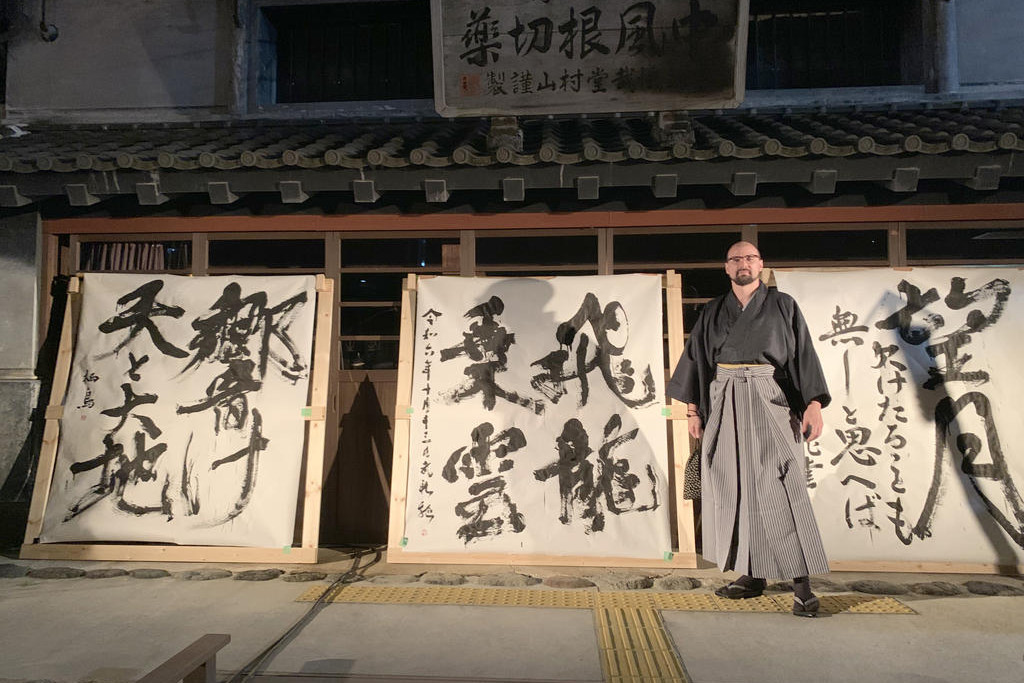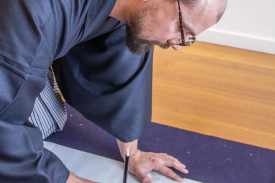General News
11 July, 2025
Shades of Shodo: the art of writing from Natimuk to Tokyo
WITH an unusual interest in the precision and art of Japanese calligraphy, Natimuk local, Blake Wardell, will likely be forever correcting his Aussie compatriots in how to pronounce the word that describes his passion.

“Sho (sure)–do (doh),” he quipped in syllable-timed fashion, with the trailing edge of the syllables clipped.
“You’ve got to kind of pretend you’re putting on a Japanese accent."
After spending significant time in Japan from 2019 and learning not just the language, he’s now got much of the relevant background required to master Shodo, a more than 1500-year-old cultural artform.
“I did my undergraduate degree at the university of New England, and as part of that I was required to do one year’s exchange at a Japanese university as my major was Japanese language,” Mr Wardell said.
“The university I went to just happened to be one of the best unis (Daito Bunka) in Japan for calligraphy, so I took a beginners class and I really liked it.”
With his interest considerably awakened, a Japanese friend knew someone who actually ran a calligraphy school, so he signed up for more advanced tutelage while he continued to study.
Suzuki Seicho’s calligraphy school is in Shiki-city to the north-west of Tokyo, and despite returning to Australia in early 2023, he has continued to study under her by distance until now.
“Last October, I went over and I did a calligraphy performance with her and another student, accompanied by traditional Japanese musicians,” he said.
“The idea is to hopefully do that again this year in October.”
He explained how a performance consists of pinning up large sheets of paper, cut to about 1.6 x 1.75 metres, in a temporary frame in view of the audience, with the musicians positioned off to one side.
“They play a piece of music, and then you write your calligraphy while listening to the music and you try your best to – it's not always possible – but you try your best to kind of match the rhythm of the music and try to embody the music's feeling into your characters that you write,” Mr Wardell said.
He added his own fluent grasp of Japanese was critical to doing it well, but he still found it challenging.
“It is important to know what you are writing,” he admitted.
“(But) even for Japanese people – because a lot of the text you are doing is from ancient Chinese – the nuance of the poetry that you're writing can still be kind of tricky.
“Particularly as a foreigner, there's all these cultural concepts and stuff you don't understand. I'd say it's almost like another hurdle for me to kind of overcome, to be able to perfect my calligraphy.”
Another challenge has been starting the art as an adult – Japanese children learn Shuji (practising writing characters – mastering correct form, stroke order, and legibility) for years so unlike him their advancement to Shodo has been grounded in repetition and muscle memory.
But Blake said Suzuki’s work teaching students in Brazil has meant she has been able to adapt her teaching style more easily to his Australian abilities and cultural barriers.
He admitted that his starting point was “a bit of a double-edged sword” in terms of “dynamic styles”.
“In some ways, I don't have that foundational aspect, which means certain aspects of my calligraphy isn’t as good,” Mr Wardell said.
“But on the other hand, I'm not restricted by those as well, so other parts are more natural and nicer.”
The Natimuk local said he has added even more depth to his work and has added another distance teacher – Miria Mukai Sensei (who specialises in the ‘Kana’ script) – to his studies.
In Shodo, the grading system follows the traditional martial arts ranking structure, progressing from Kyū (級) to Dan (段) numbered 10 to 1, where 10th Kyū is absolute beginner and first Dan would be the ‘black belt’ of calligraphy; Blake said he is at 5th to 7th Dan, depending on the specific type of work.
Nevertheless, his work will be on display as part of an annual exhibition this month at the Tokyo Metropolitan Art Museum, where between 1000 and 1500 works are selected.
Unfortunately, his day job as a postie in Horsham meant he couldn’t be there, although he still considered it a “very important” part of his skill development to be accepted into an exhibition.
“Some exhibitions are like world class elite ones that I would definitely not get accepted into (but) this one is pretty good,” he said.
“It's my second time being accepted into it.
“Every time I submit it, I don't know if I'll get in or not. It's not like it's a 100 per cent guaranteed event based on my skill level, so I'm very happy with that.”
His non-Japanese sounding name gets noticed too.
“It does raise eyebrows in Japan because they’ve always got the artist name next to the work,” Blake said.
“And there's this strange foreign name, and they're like, ‘Oh, that's kind of odd!’”
Read More: Natimuk
